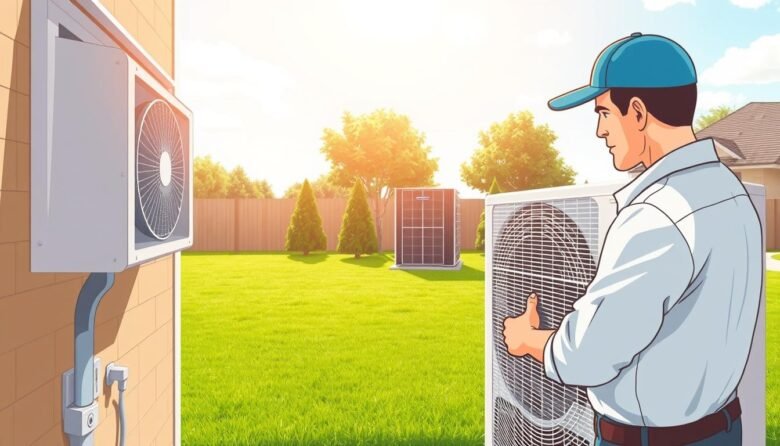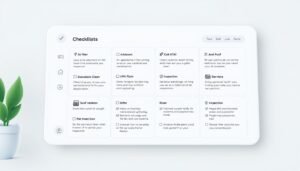When summer heat arrives, your cooling system becomes essential for comfort. Many homeowners struggle with high energy bills and uneven temperatures. Proper maintenance makes a significant difference in how your equipment performs.
Regular attention to your climate control unit ensures it runs efficiently. This approach reduces energy consumption while maintaining optimal indoor conditions. Small adjustments can yield substantial improvements in both comfort and operating costs.
A well-maintained system prevents common issues and extends equipment lifespan. This guide covers both DIY checks and professional services. You’ll learn how to achieve better air distribution and overall performance.
Key Takeaways
- Regular maintenance improves system efficiency and reduces energy costs
- Proper care extends the lifespan of your cooling equipment
- Small adjustments can significantly enhance comfort levels
- Both DIY checks and professional services contribute to optimal performance
- Addressing both indoor and outdoor components ensures comprehensive care
- Improved air distribution leads to more consistent temperatures throughout your home
- Preventative care avoids common issues and costly repairs
Why Proper AC Tuning Is Essential for Peak Performance
Proper system calibration directly impacts how effectively your home maintains comfortable temperatures. According to the U.S. Department of Energy and EPA, proper HVAC maintenance can reduce household energy bills by up to 30%. This significant saving comes from optimized energy consumption.
Regular maintenance ensures consistent comfort levels throughout your living space. Most residential systems are designed to maintain indoor air about 20 degrees below outdoor temperatures. Proper calibration prevents hot and cold spots in different rooms.
Preventative care stops small problems from becoming major issues. During peak demand periods, well-maintained equipment operates reliably. This avoids system failure when you need climate control the most.
Thermostat calibration plays a crucial role in temperature control. Accurate settings ensure your unit runs only when necessary. This precision maintains your preferred environment without wasting energy.
Optimal refrigerant levels enable efficient heat exchange. Proper maintenance keeps these levels balanced for maximum efficiency. This extends your equipment’s lifespan and reduces repair frequency over time.
Professional services can identify potential issues before they escalate. Technicians spot early warning signs during comprehensive evaluations. This proactive approach saves money and prevents discomfort.
Improved indoor air quality accompanies proper system maintenance. Clean components circulate better air throughout your home. This creates a healthier living environment for your family.
Energy savings accumulate significantly over time through proper care. The initial investment in maintenance pays for itself through reduced utility bills. Your system rewards consistent attention with reliable performance.
Common Culprits Behind Poor Cooling and High Energy Bills
Many homeowners unknowingly create conditions that force their temperature regulation equipment to consume more energy. These common issues often work together to reduce efficiency throughout your residence.
Recognizing these problems early can prevent more serious system damage. Regular attention to these areas maintains optimal comfort while controlling costs.
Dirty Air Filters Restricting Airflow
Clogged air filters represent one of the most frequent maintenance oversights. When filters accumulate dirt and debris, they create significant resistance.
This obstruction forces your HVAC equipment to work harder to move air through the system. The increased strain reduces efficiency while raising operating expenses.
Regular filter replacement maintains proper air movement through your ducts. Clean filters also improve indoor air quality throughout your home.
Blocked Vents and Dirty Condenser Coils
Furniture placement often unintentionally covers air vents throughout living spaces. These blockages disrupt proper air distribution patterns.
Similarly, outdoor condenser coils collect debris that impedes heat transfer. Dirty coils cannot effectively release heat from your residence.
Both situations cause your system to run longer cycles. This extended operation increases energy consumption without improving comfort.
Low Refrigerant Levels and Thermostat Misplacement
Insufficient refrigerant reduces your system’s capacity to absorb heat effectively. This deficiency makes the equipment less capable of maintaining desired temperatures.
Thermostat placement near heat sources causes inaccurate temperature readings. Windows, appliances, or direct sunlight can trick the thermostat.
These conditions lead to unnecessary system operation. Early signs include uneven temperatures and higher utility bills.
Addressing these common issues preserves your equipment’s longevity. Proper maintenance ensures consistent comfort while managing energy costs effectively.
How to Perform a Basic Airflow Check and Filter Inspection
Systematic examination of air movement pathways can reveal important maintenance needs. This process helps identify potential problems before they affect your home’s comfort.
Regular evaluation ensures optimal operation of your climate control equipment. Proper maintenance maintains good air quality throughout your living space.
Locating, Removing, and Evaluating Your Air Filter
Find your filter in the return air vent or air handler unit. Different systems have various placement areas for this essential component.
Carefully remove the filter for visual inspection. Hold it up to a light source to evaluate its condition.
If light doesn’t pass through easily, replacement becomes necessary. This simple test determines when your filter needs attention.
Regular filter changes prevent dust accumulation throughout your system. Clean filtration maintains proper air movement and protects internal components.
Ensuring Vents and Registers Are Clear and Open
Check all supply vents throughout your home for obstructions. Furniture or curtains often block these important openings.
Ensure each vent operates freely and remains fully open. Proper ventilation requires unobstructed air passage.
Examine return air grilles for dust buildup or blockages. These areas commonly collect debris that restricts air movement.
Listen for unusual noises during system operation. Strange sounds may indicate airflow problems requiring attention.
Clear pathways support efficient heat transfer throughout your residence. Proper insulation quality enhances this process for better overall performance.
Correct thermostat settings complement these maintenance efforts. Together they create optimal conditions for energy-efficient operation.
Checking and Maintaining Your Outdoor AC Unit
Your outdoor unit plays a crucial role in your home’s temperature control. Proper care ensures reliable operation during hot weather months. This section covers essential steps for keeping this component in optimal shape.
Regular attention prevents common problems that reduce effectiveness. These simple procedures help maintain consistent comfort levels. They also contribute to lower operating costs throughout the season.
Clearing Debris and Cleaning Condenser Coils
Remove leaves, grass clippings, and vegetation within two feet of the unit. This clearance prevents obstruction and allows proper air circulation. Keep the surrounding area clean for best results.
Gently spray the condenser coils with a garden hose to remove dirt. Always spray from the inside outward to avoid pushing debris deeper. This cleaning removes buildup that impedes heat transfer.
Clean coils operate more effectively and use less electricity. This simple task significantly impacts your equipment’s energy efficiency. Perform this cleaning at least once each season.
Straightening Bent Fins and Checking for Unusual Noises
Use a fin comb to carefully straighten any bent aluminum fins. These thin metal pieces facilitate heat exchange with the outside air. Proper alignment ensures optimal thermal transfer.
Listen for grinding or squealing sounds during operation. These noises often indicate issues with the fan motor or blades. Address unusual sounds promptly to prevent further damage.
Regular visual inspections help identify problems early. Look for damaged components or unusual wear patterns. These checks contribute to your system’s longevity and reliability.
Proper outdoor unit care directly affects indoor air quality. It also supports overall hvac system efficiency. Consistent attention prevents major repairs and maintains comfort.
Optimizing Your Thermostat for Maximum Efficiency
Your thermostat serves as the command center for your home’s climate management. Proper configuration ensures your equipment operates only when necessary. This approach maintains comfort while minimizing energy consumption.
Verifying Correct Settings and Calibration
Begin by confirming your thermostat mode selection. Ensure it’s set to “COOL” rather than “FAN” or “AUTO” settings. This prevents unnecessary operation during temperature regulation.
Check that your temperature setting sits 3-5 degrees below room temperature. This differential triggers proper system activation. Verify battery status if your model uses battery power.
Thermostat placement significantly affects reading accuracy. Keep it away from heat sources like windows or appliances. Proper location ensures accurate temperature monitoring throughout your space.
Regular calibration checks maintain precision in temperature control. Compare thermostat readings with a separate thermometer for verification. Adjustments may be needed if discrepancies exceed two degrees.
Understanding Fan Speed and Programmable Settings
Fan speed selection impacts both comfort and humidity control. Higher speeds move more air but reduce dehumidification effects. Lower speeds provide better moisture removal during operation.
Programmable settings offer significant energy savings opportunities. Set higher temperatures when occupants are away or sleeping. These adjustments reduce unnecessary cooling during absences.
Smart thermostat features enhance overall system performance. Learning algorithms adapt to your schedule and preferences. Remote access allows adjustments from anywhere using mobile devices.
Proper thermostat optimization contributes to consistent comfort levels. It also reduces strain on your equipment components. This approach extends system lifespan while lowering operating costs.
Address common issues like incorrect mode selection or placement problems. Regular maintenance checks ensure continued accurate operation. These practices support efficient temperature management throughout your home.
What a Professional AC Tuning Service Includes
Professional maintenance goes beyond basic homeowner tasks. Certified technicians perform comprehensive evaluations using specialized tools. Their expertise identifies issues that might otherwise go unnoticed.
Inspecting Electrical Components and Refrigerant Levels
Technicians examine all electrical connections within your climate control unit. They tighten loose terminals and check for corrosion or wear. This prevents potential electrical failures during peak demand periods.
Refrigerant levels receive careful attention using precision gauges. Proper charge ensures efficient heat transfer throughout your system. Technicians perform pressure tests to detect any leaks that could impact performance.
Correct refrigerant balance maintains optimal temperature control. Improper levels force your equipment to work harder. This increases energy consumption and may cause premature unit failure over time.
Evaluating Ductwork and Cleaning the Condensation Line
Duct systems undergo thorough inspection for leaks or damage. Professionals use specialized equipment to assess airflow integrity. They identify areas where conditioned air escapes before reaching living spaces.
The condensation line requires regular cleaning to prevent clogs. Technicians remove accumulated dirt and debris that cause blockages. This maintenance prevents water damage to your home and equipment.
Clean drainage systems protect your indoor environment from moisture issues. Proper duct evaluation ensures consistent temperatures throughout all rooms. These professional services complement your regular maintenance routine.
Comprehensive tuning addresses issues that DIY methods might miss. Timing these services before cooling seasons ensures peak readiness. Professional care extends your system’s lifespan while maintaining efficiency.
Practical Tips for Reducing Your Energy Consumption
Smart energy management practices transform how your home consumes electricity during warm months. These strategies work together to maintain comfort while lowering operating costs. Implementing multiple approaches creates the most significant impact on your monthly bills.
Ideal Thermostat Settings and Sealing Air Leaks
Program your thermostat to 78°F when occupants are present. Raise this setting by 7-10 degrees during extended absences. Each degree below 78°F increases energy consumption by 3-5%.
Identify air leaks around windows and doors using incense sticks or smoke pencils. Seal these openings with weatherstripping or caulk to prevent conditioned air escape. Pay special attention to areas where different building materials meet.
Proper sealing prevents your system from working harder to maintain temperatures. This reduces strain on components and extends equipment lifespan. Address ductwork leaks using mastic sealant or metal-backed tape.
The Role of Insulation and Ceiling Fans
Evaluate insulation levels in attics and exterior walls. Proper insulation reduces heat transfer between indoor and outdoor environments. This maintains consistent temperatures with less energy input.
Install ceiling fans to enhance air movement throughout living spaces. These fixtures create wind chill effects that make rooms feel cooler. This allows for higher thermostat settings without sacrificing comfort.
Set fans to rotate counterclockwise during summer months. This direction pushes air downward for better circulation. Remember that fans cool people, not rooms – turn them off when spaces are unoccupied.
Regular filter maintenance supports overall system efficiency. Replace dirty air filters monthly during peak usage periods. Clean filters prevent your equipment from working harder than necessary.
Watch for signs like uneven temperatures or increased runtime. These indicators suggest when energy-saving measures need adjustment. Proper vent management ensures balanced air distribution throughout your home.
Combining these strategies creates cumulative benefits for your household. They work together to reduce energy consumption significantly. Your hvac system operates more efficiently with these practical adjustments.
Knowing When to Call a Professional for Your System
Some issues require expert attention beyond routine maintenance. Recognize when professional help becomes necessary for optimal operation.
Persistent warm air output indicates serious internal problems. Unusual grinding or rattling noises often signal mechanical failures. Frequent cycling on and off suggests control or sensor issues.
Ice formation on components points to refrigerant or airflow concerns. These situations demand certified technician intervention for proper resolution.
Older units benefit from professional quality assessments. Systems over ten years old may need specialized checks. Technicians can evaluate coil condition and insulation effectiveness.
Dust accumulation in hard-to-reach areas requires professional cleaning equipment. Debris removal from internal components ensures proper function. Leak detection and repair need specialized tools and expertise.
Regular professional maintenance prevents major problems. It maintains system efficiency and extends equipment lifespan.



